Digital Business: AI, Blockchain, Cloud Computing & Transformation
VerifiedAdded on 2023/06/13
|10
|2940
|471
Report
AI Summary
This report explores the transformative impact of digital innovations such as artificial intelligence (AI), blockchain, and cloud computing on contemporary business. It highlights the necessity of these technologies for competitive survival, detailing their development, importance, and application in transforming business operations. The report discusses how these technologies, including data analytics, are used by organizations like Netflix to enhance customer experience, improve decision-making, and expand global reach. It also emphasizes the relevance of these digital innovations to business management theories, showing how practices are evolving to integrate technology for improved efficiency and competitive advantage, and concludes that understanding and implementing these technologies is crucial for modern business success. Desklib offers a wealth of resources, including past papers and solved assignments, to further assist students in mastering these critical concepts.

DIGITAL BUSINESS & NEW
TECHNOLOGIES
1
TECHNOLOGIES
1
Paraphrase This Document
Need a fresh take? Get an instant paraphrase of this document with our AI Paraphraser
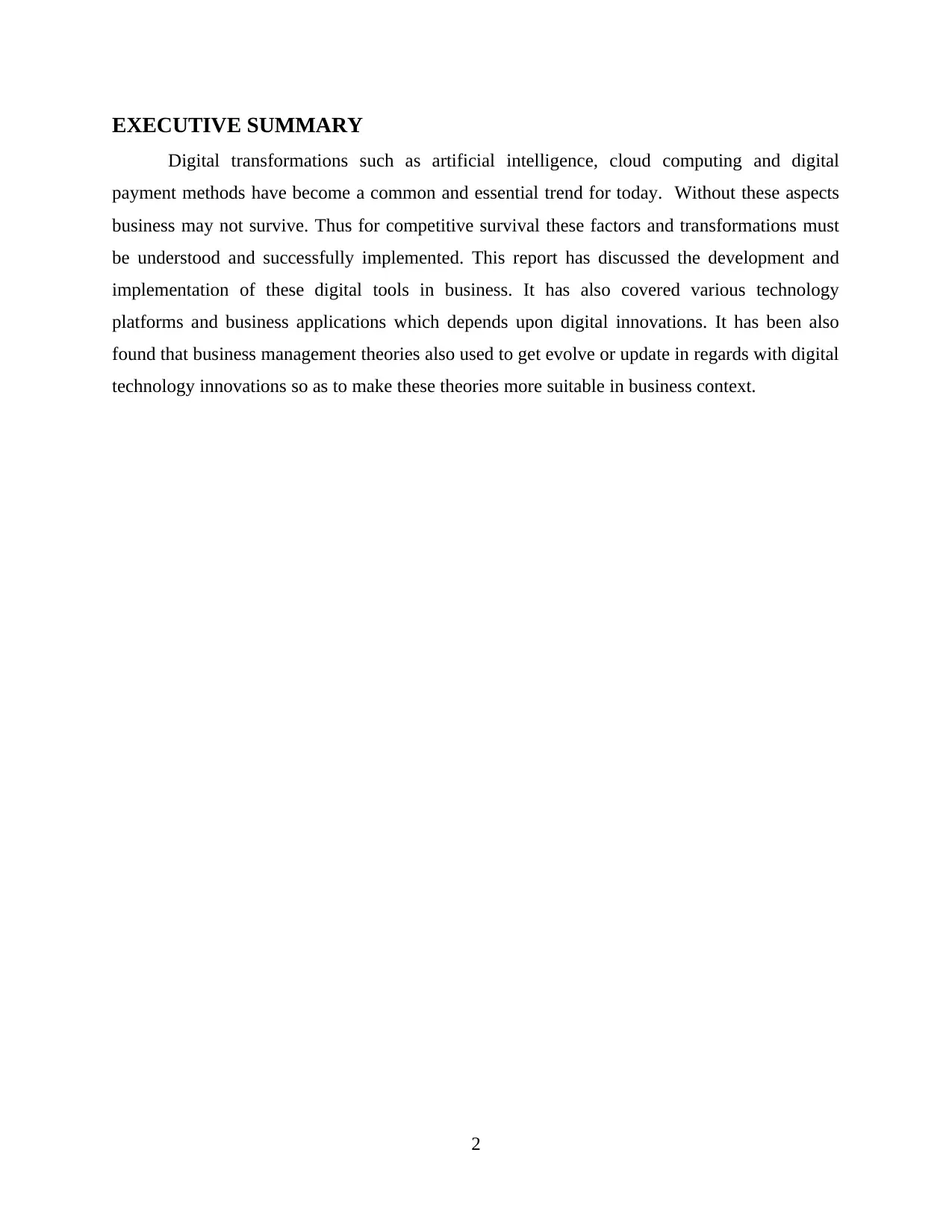
EXECUTIVE SUMMARY
Digital transformations such as artificial intelligence, cloud computing and digital
payment methods have become a common and essential trend for today. Without these aspects
business may not survive. Thus for competitive survival these factors and transformations must
be understood and successfully implemented. This report has discussed the development and
implementation of these digital tools in business. It has also covered various technology
platforms and business applications which depends upon digital innovations. It has been also
found that business management theories also used to get evolve or update in regards with digital
technology innovations so as to make these theories more suitable in business context.
2
Digital transformations such as artificial intelligence, cloud computing and digital
payment methods have become a common and essential trend for today. Without these aspects
business may not survive. Thus for competitive survival these factors and transformations must
be understood and successfully implemented. This report has discussed the development and
implementation of these digital tools in business. It has also covered various technology
platforms and business applications which depends upon digital innovations. It has been also
found that business management theories also used to get evolve or update in regards with digital
technology innovations so as to make these theories more suitable in business context.
2
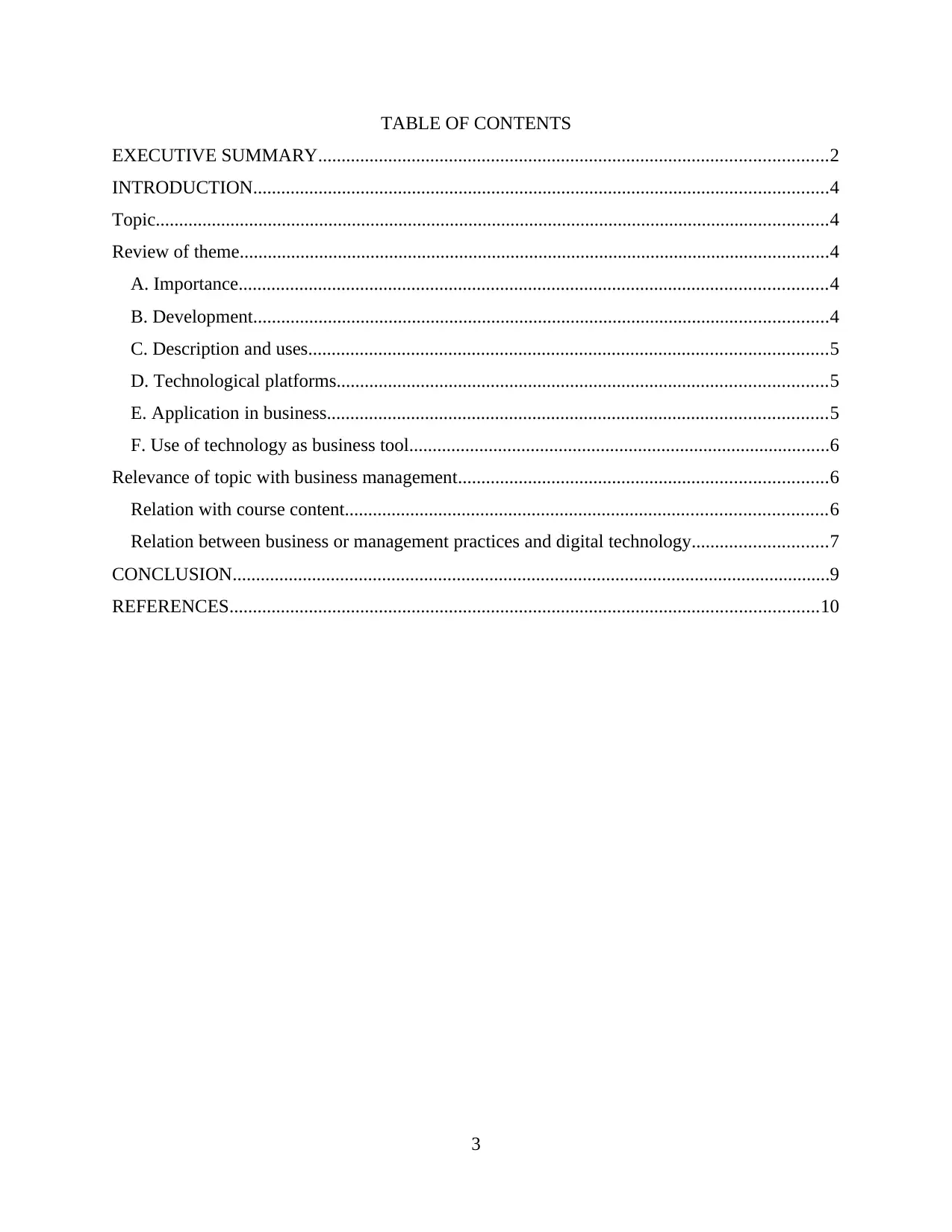
TABLE OF CONTENTS
EXECUTIVE SUMMARY.............................................................................................................2
INTRODUCTION...........................................................................................................................4
Topic................................................................................................................................................4
Review of theme..............................................................................................................................4
A. Importance..............................................................................................................................4
B. Development...........................................................................................................................4
C. Description and uses...............................................................................................................5
D. Technological platforms.........................................................................................................5
E. Application in business...........................................................................................................5
F. Use of technology as business tool..........................................................................................6
Relevance of topic with business management...............................................................................6
Relation with course content.......................................................................................................6
Relation between business or management practices and digital technology.............................7
CONCLUSION................................................................................................................................9
REFERENCES..............................................................................................................................10
3
EXECUTIVE SUMMARY.............................................................................................................2
INTRODUCTION...........................................................................................................................4
Topic................................................................................................................................................4
Review of theme..............................................................................................................................4
A. Importance..............................................................................................................................4
B. Development...........................................................................................................................4
C. Description and uses...............................................................................................................5
D. Technological platforms.........................................................................................................5
E. Application in business...........................................................................................................5
F. Use of technology as business tool..........................................................................................6
Relevance of topic with business management...............................................................................6
Relation with course content.......................................................................................................6
Relation between business or management practices and digital technology.............................7
CONCLUSION................................................................................................................................9
REFERENCES..............................................................................................................................10
3
⊘ This is a preview!⊘
Do you want full access?
Subscribe today to unlock all pages.

Trusted by 1+ million students worldwide
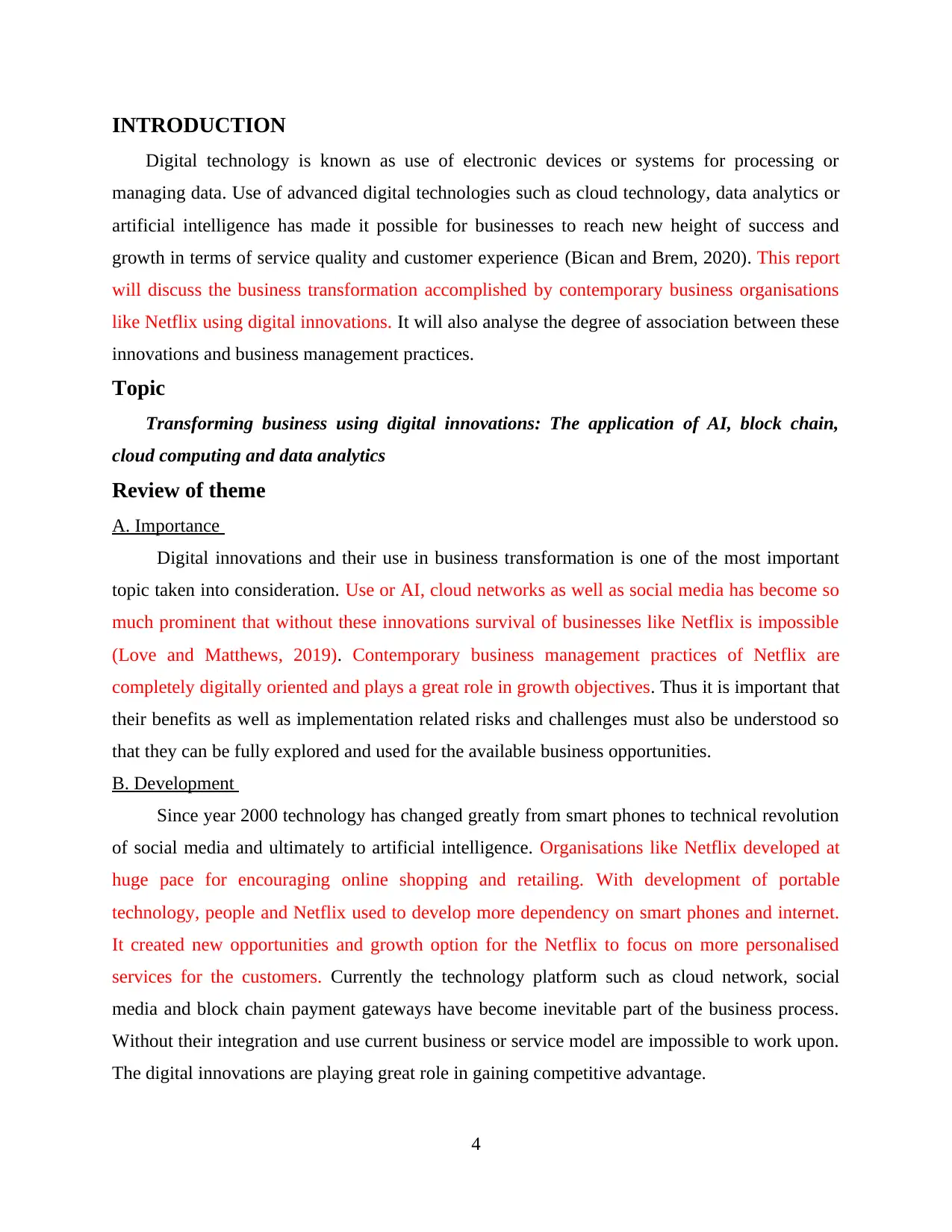
INTRODUCTION
Digital technology is known as use of electronic devices or systems for processing or
managing data. Use of advanced digital technologies such as cloud technology, data analytics or
artificial intelligence has made it possible for businesses to reach new height of success and
growth in terms of service quality and customer experience (Bican and Brem, 2020). This report
will discuss the business transformation accomplished by contemporary business organisations
like Netflix using digital innovations. It will also analyse the degree of association between these
innovations and business management practices.
Topic
Transforming business using digital innovations: The application of AI, block chain,
cloud computing and data analytics
Review of theme
A. Importance
Digital innovations and their use in business transformation is one of the most important
topic taken into consideration. Use or AI, cloud networks as well as social media has become so
much prominent that without these innovations survival of businesses like Netflix is impossible
(Love and Matthews, 2019). Contemporary business management practices of Netflix are
completely digitally oriented and plays a great role in growth objectives. Thus it is important that
their benefits as well as implementation related risks and challenges must also be understood so
that they can be fully explored and used for the available business opportunities.
B. Development
Since year 2000 technology has changed greatly from smart phones to technical revolution
of social media and ultimately to artificial intelligence. Organisations like Netflix developed at
huge pace for encouraging online shopping and retailing. With development of portable
technology, people and Netflix used to develop more dependency on smart phones and internet.
It created new opportunities and growth option for the Netflix to focus on more personalised
services for the customers. Currently the technology platform such as cloud network, social
media and block chain payment gateways have become inevitable part of the business process.
Without their integration and use current business or service model are impossible to work upon.
The digital innovations are playing great role in gaining competitive advantage.
4
Digital technology is known as use of electronic devices or systems for processing or
managing data. Use of advanced digital technologies such as cloud technology, data analytics or
artificial intelligence has made it possible for businesses to reach new height of success and
growth in terms of service quality and customer experience (Bican and Brem, 2020). This report
will discuss the business transformation accomplished by contemporary business organisations
like Netflix using digital innovations. It will also analyse the degree of association between these
innovations and business management practices.
Topic
Transforming business using digital innovations: The application of AI, block chain,
cloud computing and data analytics
Review of theme
A. Importance
Digital innovations and their use in business transformation is one of the most important
topic taken into consideration. Use or AI, cloud networks as well as social media has become so
much prominent that without these innovations survival of businesses like Netflix is impossible
(Love and Matthews, 2019). Contemporary business management practices of Netflix are
completely digitally oriented and plays a great role in growth objectives. Thus it is important that
their benefits as well as implementation related risks and challenges must also be understood so
that they can be fully explored and used for the available business opportunities.
B. Development
Since year 2000 technology has changed greatly from smart phones to technical revolution
of social media and ultimately to artificial intelligence. Organisations like Netflix developed at
huge pace for encouraging online shopping and retailing. With development of portable
technology, people and Netflix used to develop more dependency on smart phones and internet.
It created new opportunities and growth option for the Netflix to focus on more personalised
services for the customers. Currently the technology platform such as cloud network, social
media and block chain payment gateways have become inevitable part of the business process.
Without their integration and use current business or service model are impossible to work upon.
The digital innovations are playing great role in gaining competitive advantage.
4
Paraphrase This Document
Need a fresh take? Get an instant paraphrase of this document with our AI Paraphraser
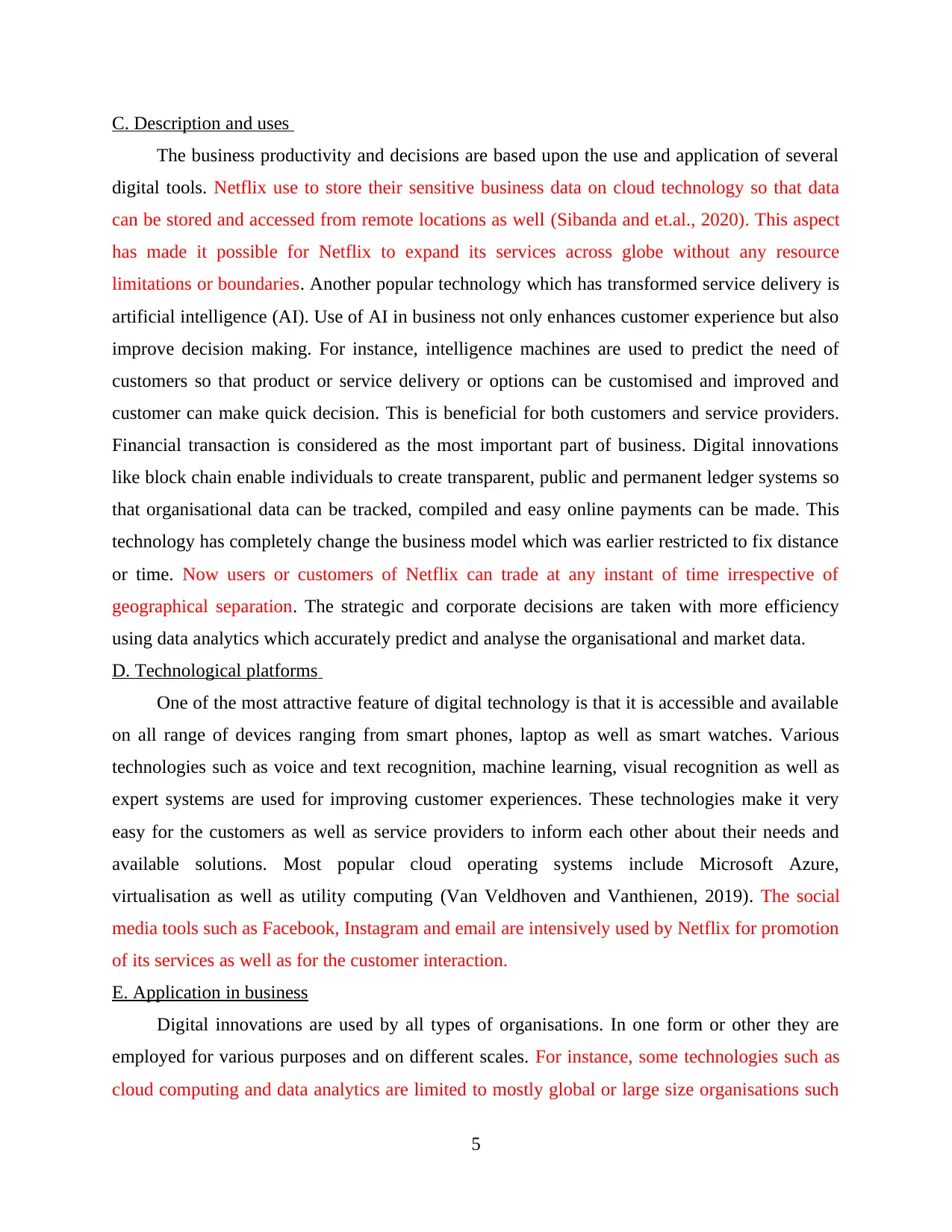
C. Description and uses
The business productivity and decisions are based upon the use and application of several
digital tools. Netflix use to store their sensitive business data on cloud technology so that data
can be stored and accessed from remote locations as well (Sibanda and et.al., 2020). This aspect
has made it possible for Netflix to expand its services across globe without any resource
limitations or boundaries. Another popular technology which has transformed service delivery is
artificial intelligence (AI). Use of AI in business not only enhances customer experience but also
improve decision making. For instance, intelligence machines are used to predict the need of
customers so that product or service delivery or options can be customised and improved and
customer can make quick decision. This is beneficial for both customers and service providers.
Financial transaction is considered as the most important part of business. Digital innovations
like block chain enable individuals to create transparent, public and permanent ledger systems so
that organisational data can be tracked, compiled and easy online payments can be made. This
technology has completely change the business model which was earlier restricted to fix distance
or time. Now users or customers of Netflix can trade at any instant of time irrespective of
geographical separation. The strategic and corporate decisions are taken with more efficiency
using data analytics which accurately predict and analyse the organisational and market data.
D. Technological platforms
One of the most attractive feature of digital technology is that it is accessible and available
on all range of devices ranging from smart phones, laptop as well as smart watches. Various
technologies such as voice and text recognition, machine learning, visual recognition as well as
expert systems are used for improving customer experiences. These technologies make it very
easy for the customers as well as service providers to inform each other about their needs and
available solutions. Most popular cloud operating systems include Microsoft Azure,
virtualisation as well as utility computing (Van Veldhoven and Vanthienen, 2019). The social
media tools such as Facebook, Instagram and email are intensively used by Netflix for promotion
of its services as well as for the customer interaction.
E. Application in business
Digital innovations are used by all types of organisations. In one form or other they are
employed for various purposes and on different scales. For instance, some technologies such as
cloud computing and data analytics are limited to mostly global or large size organisations such
5
The business productivity and decisions are based upon the use and application of several
digital tools. Netflix use to store their sensitive business data on cloud technology so that data
can be stored and accessed from remote locations as well (Sibanda and et.al., 2020). This aspect
has made it possible for Netflix to expand its services across globe without any resource
limitations or boundaries. Another popular technology which has transformed service delivery is
artificial intelligence (AI). Use of AI in business not only enhances customer experience but also
improve decision making. For instance, intelligence machines are used to predict the need of
customers so that product or service delivery or options can be customised and improved and
customer can make quick decision. This is beneficial for both customers and service providers.
Financial transaction is considered as the most important part of business. Digital innovations
like block chain enable individuals to create transparent, public and permanent ledger systems so
that organisational data can be tracked, compiled and easy online payments can be made. This
technology has completely change the business model which was earlier restricted to fix distance
or time. Now users or customers of Netflix can trade at any instant of time irrespective of
geographical separation. The strategic and corporate decisions are taken with more efficiency
using data analytics which accurately predict and analyse the organisational and market data.
D. Technological platforms
One of the most attractive feature of digital technology is that it is accessible and available
on all range of devices ranging from smart phones, laptop as well as smart watches. Various
technologies such as voice and text recognition, machine learning, visual recognition as well as
expert systems are used for improving customer experiences. These technologies make it very
easy for the customers as well as service providers to inform each other about their needs and
available solutions. Most popular cloud operating systems include Microsoft Azure,
virtualisation as well as utility computing (Van Veldhoven and Vanthienen, 2019). The social
media tools such as Facebook, Instagram and email are intensively used by Netflix for promotion
of its services as well as for the customer interaction.
E. Application in business
Digital innovations are used by all types of organisations. In one form or other they are
employed for various purposes and on different scales. For instance, some technologies such as
cloud computing and data analytics are limited to mostly global or large size organisations such
5
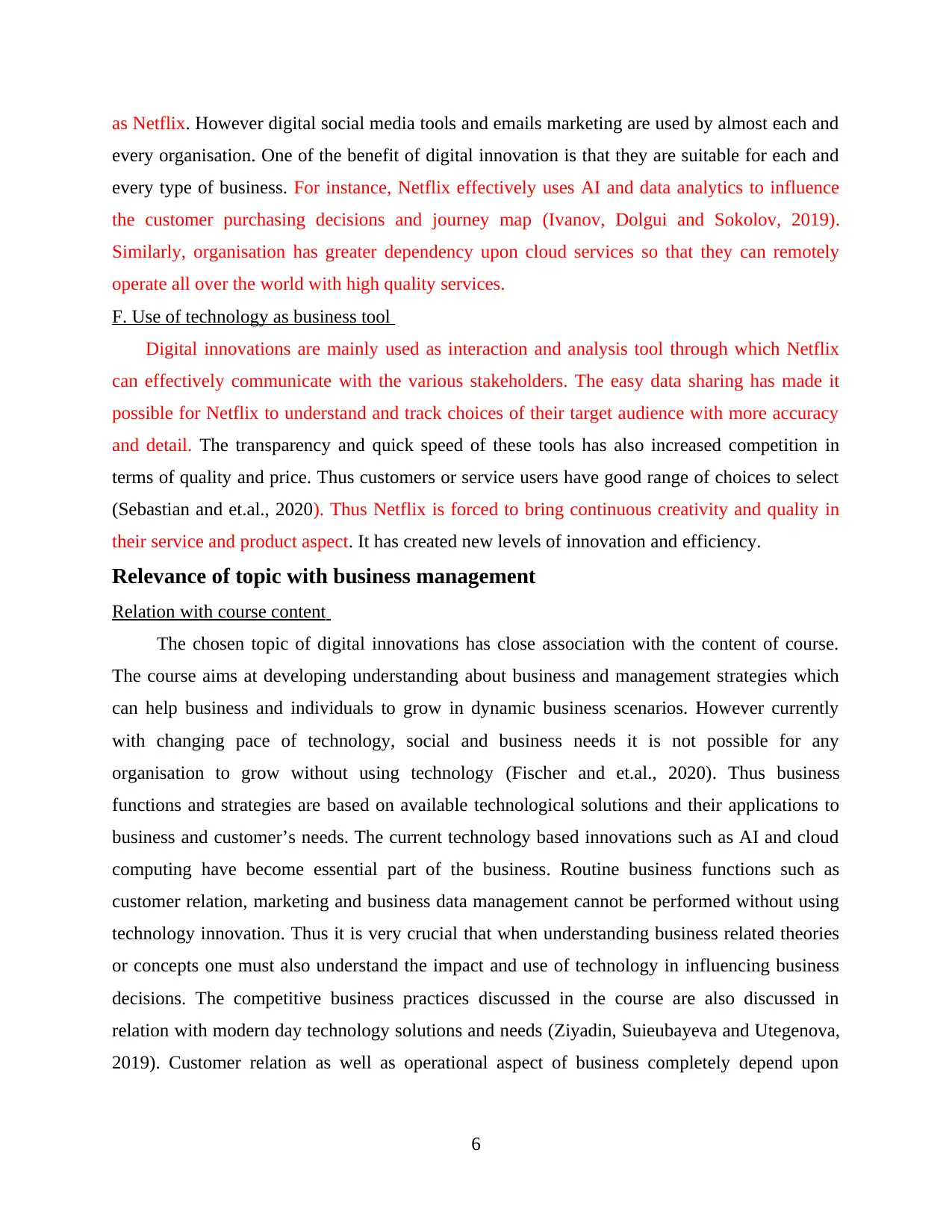
as Netflix. However digital social media tools and emails marketing are used by almost each and
every organisation. One of the benefit of digital innovation is that they are suitable for each and
every type of business. For instance, Netflix effectively uses AI and data analytics to influence
the customer purchasing decisions and journey map (Ivanov, Dolgui and Sokolov, 2019).
Similarly, organisation has greater dependency upon cloud services so that they can remotely
operate all over the world with high quality services.
F. Use of technology as business tool
Digital innovations are mainly used as interaction and analysis tool through which Netflix
can effectively communicate with the various stakeholders. The easy data sharing has made it
possible for Netflix to understand and track choices of their target audience with more accuracy
and detail. The transparency and quick speed of these tools has also increased competition in
terms of quality and price. Thus customers or service users have good range of choices to select
(Sebastian and et.al., 2020). Thus Netflix is forced to bring continuous creativity and quality in
their service and product aspect. It has created new levels of innovation and efficiency.
Relevance of topic with business management
Relation with course content
The chosen topic of digital innovations has close association with the content of course.
The course aims at developing understanding about business and management strategies which
can help business and individuals to grow in dynamic business scenarios. However currently
with changing pace of technology, social and business needs it is not possible for any
organisation to grow without using technology (Fischer and et.al., 2020). Thus business
functions and strategies are based on available technological solutions and their applications to
business and customer’s needs. The current technology based innovations such as AI and cloud
computing have become essential part of the business. Routine business functions such as
customer relation, marketing and business data management cannot be performed without using
technology innovation. Thus it is very crucial that when understanding business related theories
or concepts one must also understand the impact and use of technology in influencing business
decisions. The competitive business practices discussed in the course are also discussed in
relation with modern day technology solutions and needs (Ziyadin, Suieubayeva and Utegenova,
2019). Customer relation as well as operational aspect of business completely depend upon
6
every organisation. One of the benefit of digital innovation is that they are suitable for each and
every type of business. For instance, Netflix effectively uses AI and data analytics to influence
the customer purchasing decisions and journey map (Ivanov, Dolgui and Sokolov, 2019).
Similarly, organisation has greater dependency upon cloud services so that they can remotely
operate all over the world with high quality services.
F. Use of technology as business tool
Digital innovations are mainly used as interaction and analysis tool through which Netflix
can effectively communicate with the various stakeholders. The easy data sharing has made it
possible for Netflix to understand and track choices of their target audience with more accuracy
and detail. The transparency and quick speed of these tools has also increased competition in
terms of quality and price. Thus customers or service users have good range of choices to select
(Sebastian and et.al., 2020). Thus Netflix is forced to bring continuous creativity and quality in
their service and product aspect. It has created new levels of innovation and efficiency.
Relevance of topic with business management
Relation with course content
The chosen topic of digital innovations has close association with the content of course.
The course aims at developing understanding about business and management strategies which
can help business and individuals to grow in dynamic business scenarios. However currently
with changing pace of technology, social and business needs it is not possible for any
organisation to grow without using technology (Fischer and et.al., 2020). Thus business
functions and strategies are based on available technological solutions and their applications to
business and customer’s needs. The current technology based innovations such as AI and cloud
computing have become essential part of the business. Routine business functions such as
customer relation, marketing and business data management cannot be performed without using
technology innovation. Thus it is very crucial that when understanding business related theories
or concepts one must also understand the impact and use of technology in influencing business
decisions. The competitive business practices discussed in the course are also discussed in
relation with modern day technology solutions and needs (Ziyadin, Suieubayeva and Utegenova,
2019). Customer relation as well as operational aspect of business completely depend upon
6
⊘ This is a preview!⊘
Do you want full access?
Subscribe today to unlock all pages.

Trusted by 1+ million students worldwide
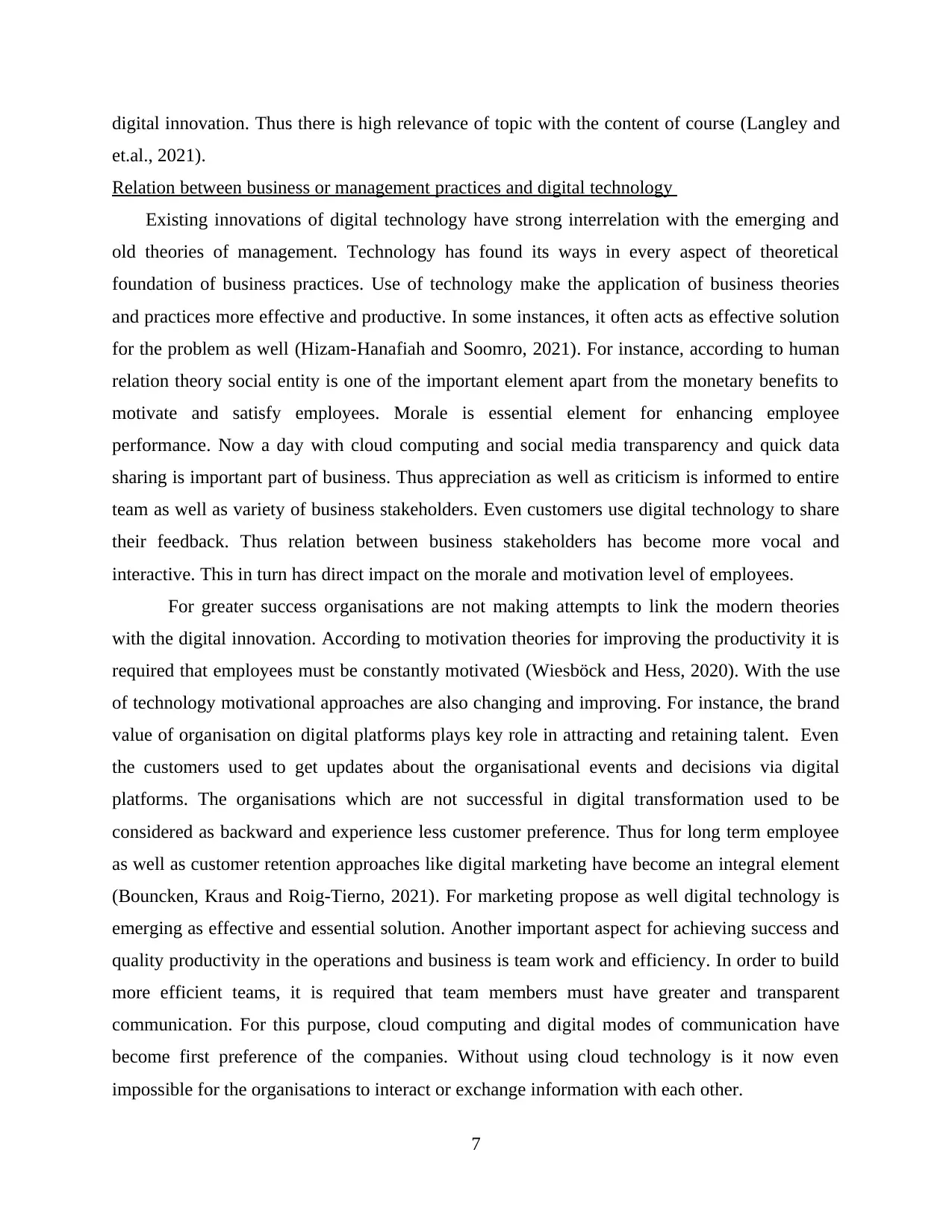
digital innovation. Thus there is high relevance of topic with the content of course (Langley and
et.al., 2021).
Relation between business or management practices and digital technology
Existing innovations of digital technology have strong interrelation with the emerging and
old theories of management. Technology has found its ways in every aspect of theoretical
foundation of business practices. Use of technology make the application of business theories
and practices more effective and productive. In some instances, it often acts as effective solution
for the problem as well (Hizam-Hanafiah and Soomro, 2021). For instance, according to human
relation theory social entity is one of the important element apart from the monetary benefits to
motivate and satisfy employees. Morale is essential element for enhancing employee
performance. Now a day with cloud computing and social media transparency and quick data
sharing is important part of business. Thus appreciation as well as criticism is informed to entire
team as well as variety of business stakeholders. Even customers use digital technology to share
their feedback. Thus relation between business stakeholders has become more vocal and
interactive. This in turn has direct impact on the morale and motivation level of employees.
For greater success organisations are not making attempts to link the modern theories
with the digital innovation. According to motivation theories for improving the productivity it is
required that employees must be constantly motivated (Wiesböck and Hess, 2020). With the use
of technology motivational approaches are also changing and improving. For instance, the brand
value of organisation on digital platforms plays key role in attracting and retaining talent. Even
the customers used to get updates about the organisational events and decisions via digital
platforms. The organisations which are not successful in digital transformation used to be
considered as backward and experience less customer preference. Thus for long term employee
as well as customer retention approaches like digital marketing have become an integral element
(Bouncken, Kraus and Roig-Tierno, 2021). For marketing propose as well digital technology is
emerging as effective and essential solution. Another important aspect for achieving success and
quality productivity in the operations and business is team work and efficiency. In order to build
more efficient teams, it is required that team members must have greater and transparent
communication. For this purpose, cloud computing and digital modes of communication have
become first preference of the companies. Without using cloud technology is it now even
impossible for the organisations to interact or exchange information with each other.
7
et.al., 2021).
Relation between business or management practices and digital technology
Existing innovations of digital technology have strong interrelation with the emerging and
old theories of management. Technology has found its ways in every aspect of theoretical
foundation of business practices. Use of technology make the application of business theories
and practices more effective and productive. In some instances, it often acts as effective solution
for the problem as well (Hizam-Hanafiah and Soomro, 2021). For instance, according to human
relation theory social entity is one of the important element apart from the monetary benefits to
motivate and satisfy employees. Morale is essential element for enhancing employee
performance. Now a day with cloud computing and social media transparency and quick data
sharing is important part of business. Thus appreciation as well as criticism is informed to entire
team as well as variety of business stakeholders. Even customers use digital technology to share
their feedback. Thus relation between business stakeholders has become more vocal and
interactive. This in turn has direct impact on the morale and motivation level of employees.
For greater success organisations are not making attempts to link the modern theories
with the digital innovation. According to motivation theories for improving the productivity it is
required that employees must be constantly motivated (Wiesböck and Hess, 2020). With the use
of technology motivational approaches are also changing and improving. For instance, the brand
value of organisation on digital platforms plays key role in attracting and retaining talent. Even
the customers used to get updates about the organisational events and decisions via digital
platforms. The organisations which are not successful in digital transformation used to be
considered as backward and experience less customer preference. Thus for long term employee
as well as customer retention approaches like digital marketing have become an integral element
(Bouncken, Kraus and Roig-Tierno, 2021). For marketing propose as well digital technology is
emerging as effective and essential solution. Another important aspect for achieving success and
quality productivity in the operations and business is team work and efficiency. In order to build
more efficient teams, it is required that team members must have greater and transparent
communication. For this purpose, cloud computing and digital modes of communication have
become first preference of the companies. Without using cloud technology is it now even
impossible for the organisations to interact or exchange information with each other.
7
Paraphrase This Document
Need a fresh take? Get an instant paraphrase of this document with our AI Paraphraser
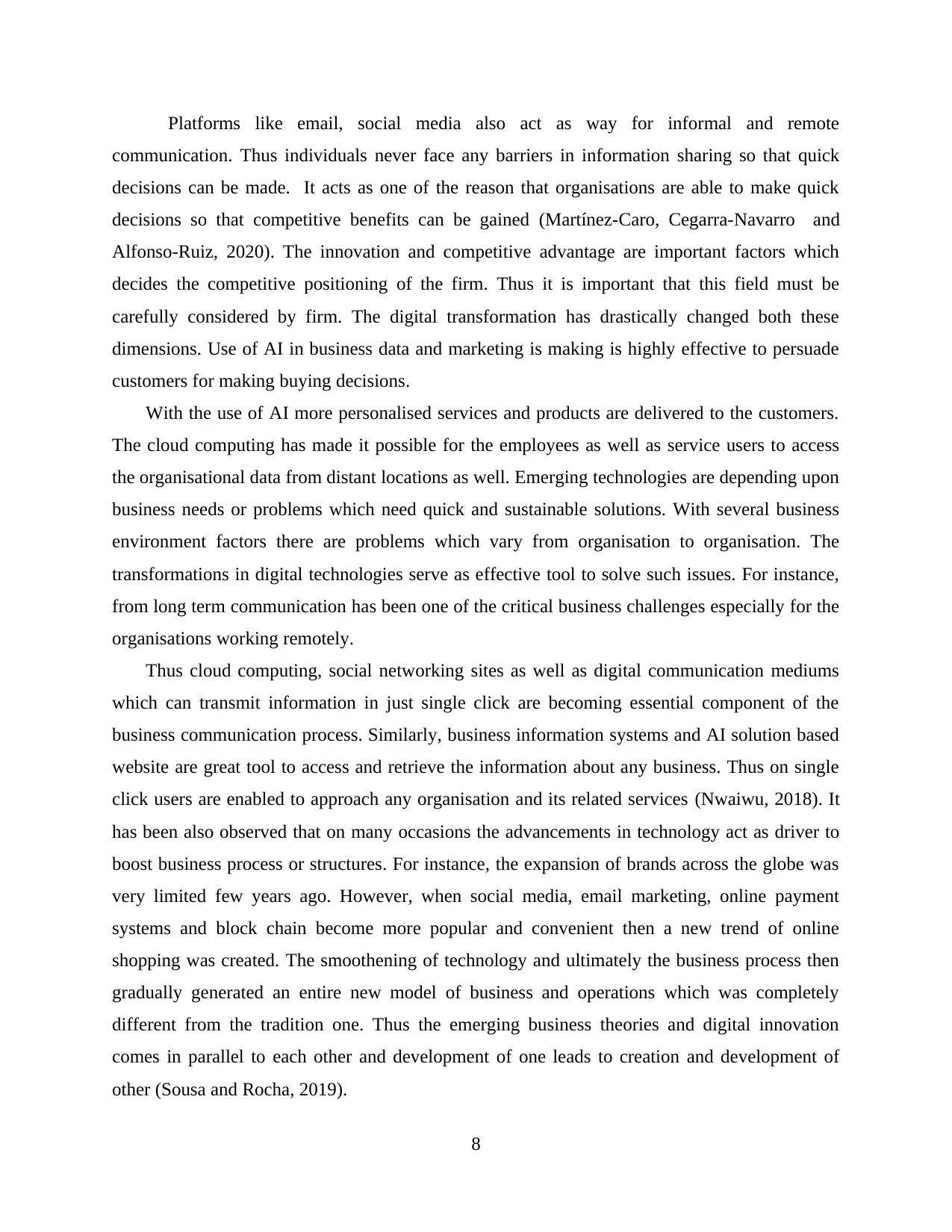
Platforms like email, social media also act as way for informal and remote
communication. Thus individuals never face any barriers in information sharing so that quick
decisions can be made. It acts as one of the reason that organisations are able to make quick
decisions so that competitive benefits can be gained (Martínez-Caro, Cegarra-Navarro and
Alfonso-Ruiz, 2020). The innovation and competitive advantage are important factors which
decides the competitive positioning of the firm. Thus it is important that this field must be
carefully considered by firm. The digital transformation has drastically changed both these
dimensions. Use of AI in business data and marketing is making is highly effective to persuade
customers for making buying decisions.
With the use of AI more personalised services and products are delivered to the customers.
The cloud computing has made it possible for the employees as well as service users to access
the organisational data from distant locations as well. Emerging technologies are depending upon
business needs or problems which need quick and sustainable solutions. With several business
environment factors there are problems which vary from organisation to organisation. The
transformations in digital technologies serve as effective tool to solve such issues. For instance,
from long term communication has been one of the critical business challenges especially for the
organisations working remotely.
Thus cloud computing, social networking sites as well as digital communication mediums
which can transmit information in just single click are becoming essential component of the
business communication process. Similarly, business information systems and AI solution based
website are great tool to access and retrieve the information about any business. Thus on single
click users are enabled to approach any organisation and its related services (Nwaiwu, 2018). It
has been also observed that on many occasions the advancements in technology act as driver to
boost business process or structures. For instance, the expansion of brands across the globe was
very limited few years ago. However, when social media, email marketing, online payment
systems and block chain become more popular and convenient then a new trend of online
shopping was created. The smoothening of technology and ultimately the business process then
gradually generated an entire new model of business and operations which was completely
different from the tradition one. Thus the emerging business theories and digital innovation
comes in parallel to each other and development of one leads to creation and development of
other (Sousa and Rocha, 2019).
8
communication. Thus individuals never face any barriers in information sharing so that quick
decisions can be made. It acts as one of the reason that organisations are able to make quick
decisions so that competitive benefits can be gained (Martínez-Caro, Cegarra-Navarro and
Alfonso-Ruiz, 2020). The innovation and competitive advantage are important factors which
decides the competitive positioning of the firm. Thus it is important that this field must be
carefully considered by firm. The digital transformation has drastically changed both these
dimensions. Use of AI in business data and marketing is making is highly effective to persuade
customers for making buying decisions.
With the use of AI more personalised services and products are delivered to the customers.
The cloud computing has made it possible for the employees as well as service users to access
the organisational data from distant locations as well. Emerging technologies are depending upon
business needs or problems which need quick and sustainable solutions. With several business
environment factors there are problems which vary from organisation to organisation. The
transformations in digital technologies serve as effective tool to solve such issues. For instance,
from long term communication has been one of the critical business challenges especially for the
organisations working remotely.
Thus cloud computing, social networking sites as well as digital communication mediums
which can transmit information in just single click are becoming essential component of the
business communication process. Similarly, business information systems and AI solution based
website are great tool to access and retrieve the information about any business. Thus on single
click users are enabled to approach any organisation and its related services (Nwaiwu, 2018). It
has been also observed that on many occasions the advancements in technology act as driver to
boost business process or structures. For instance, the expansion of brands across the globe was
very limited few years ago. However, when social media, email marketing, online payment
systems and block chain become more popular and convenient then a new trend of online
shopping was created. The smoothening of technology and ultimately the business process then
gradually generated an entire new model of business and operations which was completely
different from the tradition one. Thus the emerging business theories and digital innovation
comes in parallel to each other and development of one leads to creation and development of
other (Sousa and Rocha, 2019).
8
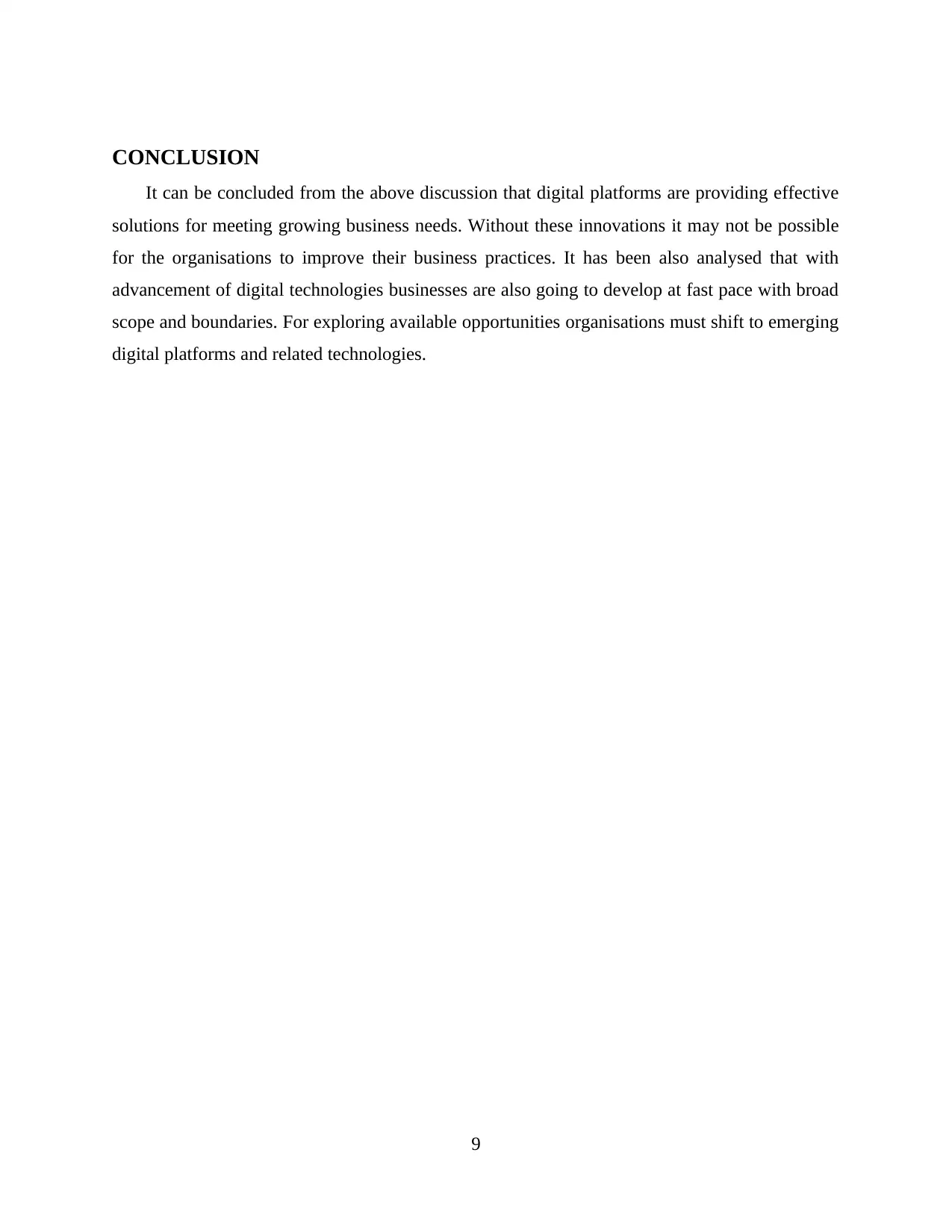
CONCLUSION
It can be concluded from the above discussion that digital platforms are providing effective
solutions for meeting growing business needs. Without these innovations it may not be possible
for the organisations to improve their business practices. It has been also analysed that with
advancement of digital technologies businesses are also going to develop at fast pace with broad
scope and boundaries. For exploring available opportunities organisations must shift to emerging
digital platforms and related technologies.
9
It can be concluded from the above discussion that digital platforms are providing effective
solutions for meeting growing business needs. Without these innovations it may not be possible
for the organisations to improve their business practices. It has been also analysed that with
advancement of digital technologies businesses are also going to develop at fast pace with broad
scope and boundaries. For exploring available opportunities organisations must shift to emerging
digital platforms and related technologies.
9
⊘ This is a preview!⊘
Do you want full access?
Subscribe today to unlock all pages.

Trusted by 1+ million students worldwide
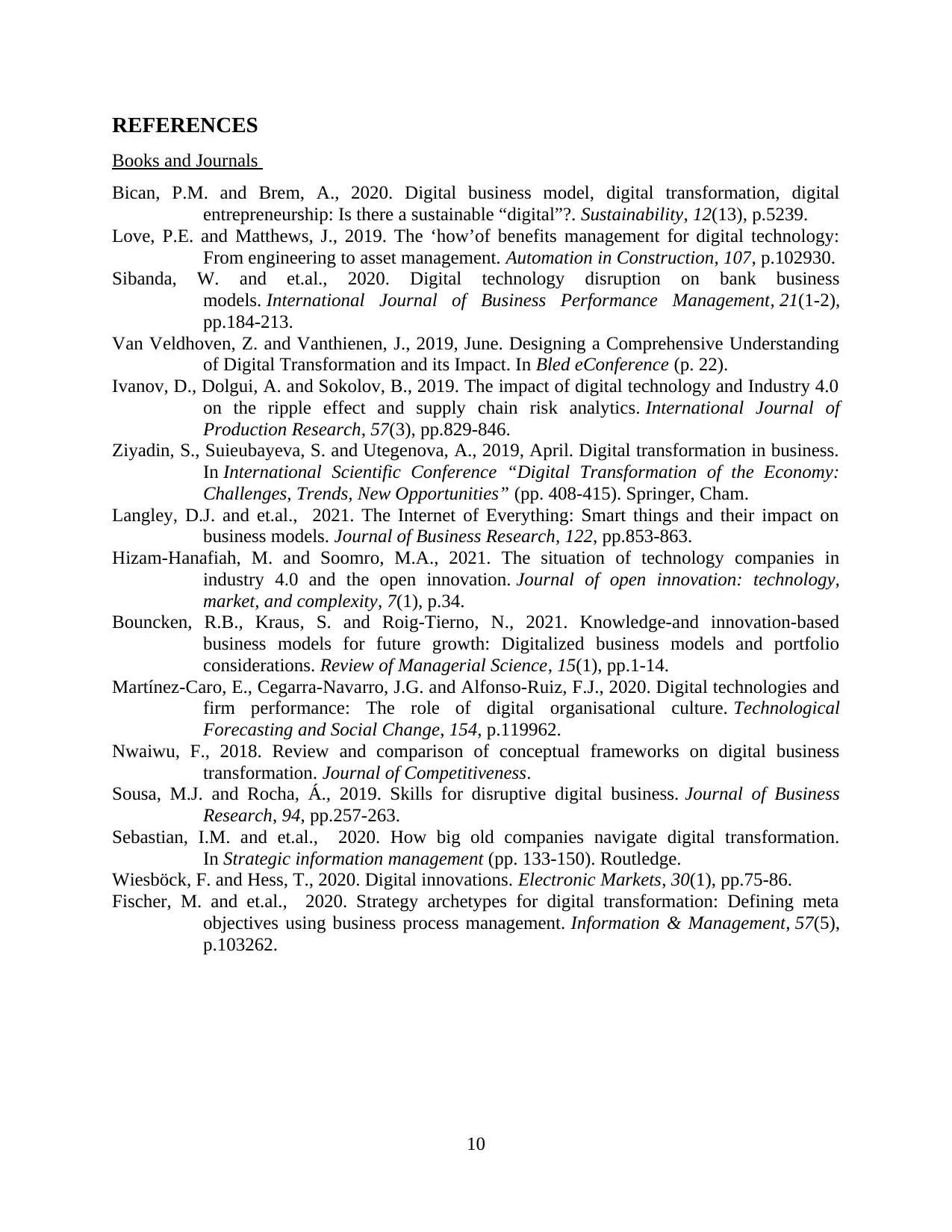
REFERENCES
Books and Journals
Bican, P.M. and Brem, A., 2020. Digital business model, digital transformation, digital
entrepreneurship: Is there a sustainable “digital”?. Sustainability, 12(13), p.5239.
Love, P.E. and Matthews, J., 2019. The ‘how’of benefits management for digital technology:
From engineering to asset management. Automation in Construction, 107, p.102930.
Sibanda, W. and et.al., 2020. Digital technology disruption on bank business
models. International Journal of Business Performance Management, 21(1-2),
pp.184-213.
Van Veldhoven, Z. and Vanthienen, J., 2019, June. Designing a Comprehensive Understanding
of Digital Transformation and its Impact. In Bled eConference (p. 22).
Ivanov, D., Dolgui, A. and Sokolov, B., 2019. The impact of digital technology and Industry 4.0
on the ripple effect and supply chain risk analytics. International Journal of
Production Research, 57(3), pp.829-846.
Ziyadin, S., Suieubayeva, S. and Utegenova, A., 2019, April. Digital transformation in business.
In International Scientific Conference “Digital Transformation of the Economy:
Challenges, Trends, New Opportunities” (pp. 408-415). Springer, Cham.
Langley, D.J. and et.al., 2021. The Internet of Everything: Smart things and their impact on
business models. Journal of Business Research, 122, pp.853-863.
Hizam-Hanafiah, M. and Soomro, M.A., 2021. The situation of technology companies in
industry 4.0 and the open innovation. Journal of open innovation: technology,
market, and complexity, 7(1), p.34.
Bouncken, R.B., Kraus, S. and Roig-Tierno, N., 2021. Knowledge-and innovation-based
business models for future growth: Digitalized business models and portfolio
considerations. Review of Managerial Science, 15(1), pp.1-14.
Martínez-Caro, E., Cegarra-Navarro, J.G. and Alfonso-Ruiz, F.J., 2020. Digital technologies and
firm performance: The role of digital organisational culture. Technological
Forecasting and Social Change, 154, p.119962.
Nwaiwu, F., 2018. Review and comparison of conceptual frameworks on digital business
transformation. Journal of Competitiveness.
Sousa, M.J. and Rocha, Á., 2019. Skills for disruptive digital business. Journal of Business
Research, 94, pp.257-263.
Sebastian, I.M. and et.al., 2020. How big old companies navigate digital transformation.
In Strategic information management (pp. 133-150). Routledge.
Wiesböck, F. and Hess, T., 2020. Digital innovations. Electronic Markets, 30(1), pp.75-86.
Fischer, M. and et.al., 2020. Strategy archetypes for digital transformation: Defining meta
objectives using business process management. Information & Management, 57(5),
p.103262.
10
Books and Journals
Bican, P.M. and Brem, A., 2020. Digital business model, digital transformation, digital
entrepreneurship: Is there a sustainable “digital”?. Sustainability, 12(13), p.5239.
Love, P.E. and Matthews, J., 2019. The ‘how’of benefits management for digital technology:
From engineering to asset management. Automation in Construction, 107, p.102930.
Sibanda, W. and et.al., 2020. Digital technology disruption on bank business
models. International Journal of Business Performance Management, 21(1-2),
pp.184-213.
Van Veldhoven, Z. and Vanthienen, J., 2019, June. Designing a Comprehensive Understanding
of Digital Transformation and its Impact. In Bled eConference (p. 22).
Ivanov, D., Dolgui, A. and Sokolov, B., 2019. The impact of digital technology and Industry 4.0
on the ripple effect and supply chain risk analytics. International Journal of
Production Research, 57(3), pp.829-846.
Ziyadin, S., Suieubayeva, S. and Utegenova, A., 2019, April. Digital transformation in business.
In International Scientific Conference “Digital Transformation of the Economy:
Challenges, Trends, New Opportunities” (pp. 408-415). Springer, Cham.
Langley, D.J. and et.al., 2021. The Internet of Everything: Smart things and their impact on
business models. Journal of Business Research, 122, pp.853-863.
Hizam-Hanafiah, M. and Soomro, M.A., 2021. The situation of technology companies in
industry 4.0 and the open innovation. Journal of open innovation: technology,
market, and complexity, 7(1), p.34.
Bouncken, R.B., Kraus, S. and Roig-Tierno, N., 2021. Knowledge-and innovation-based
business models for future growth: Digitalized business models and portfolio
considerations. Review of Managerial Science, 15(1), pp.1-14.
Martínez-Caro, E., Cegarra-Navarro, J.G. and Alfonso-Ruiz, F.J., 2020. Digital technologies and
firm performance: The role of digital organisational culture. Technological
Forecasting and Social Change, 154, p.119962.
Nwaiwu, F., 2018. Review and comparison of conceptual frameworks on digital business
transformation. Journal of Competitiveness.
Sousa, M.J. and Rocha, Á., 2019. Skills for disruptive digital business. Journal of Business
Research, 94, pp.257-263.
Sebastian, I.M. and et.al., 2020. How big old companies navigate digital transformation.
In Strategic information management (pp. 133-150). Routledge.
Wiesböck, F. and Hess, T., 2020. Digital innovations. Electronic Markets, 30(1), pp.75-86.
Fischer, M. and et.al., 2020. Strategy archetypes for digital transformation: Defining meta
objectives using business process management. Information & Management, 57(5),
p.103262.
10
1 out of 10
Related Documents
Your All-in-One AI-Powered Toolkit for Academic Success.
+13062052269
info@desklib.com
Available 24*7 on WhatsApp / Email
![[object Object]](/_next/static/media/star-bottom.7253800d.svg)
Unlock your academic potential
Copyright © 2020–2025 A2Z Services. All Rights Reserved. Developed and managed by ZUCOL.



